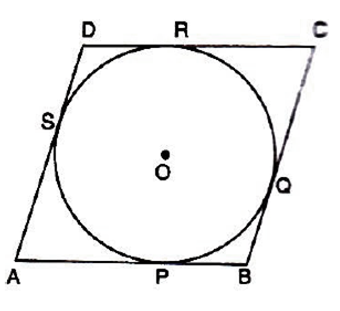Prove that the parallelogram circumscribing a circle is a rhombus.
OR
Prove that opposite sides of a quadrilateral circumscribing a circle subtend supplementary angles at the centre of the circle.
Let ABCD be a parallelogram such that its sides touching a circle with centre O.
We know that the tangents to a circle from an exterior point are equal in length.

AP = AS .......[Tangnts from point A] .......(i)
BP = BQ .......[Tangents from point B] .......(ii)
CR = CQ .......[Tangents from point C] .......(iii)
and, DR = DS .......[Tangents from point D] ........(iv)
Adding (i), (ii), (iii), and (iv), we get
AP + BP + CR + DR = AS + BQ + CQ + DS
(AP + BP) + (CR + DR) = ( AS + DS) + (BQ + CQ)
AB + CD = AD + BC
2AB = 2BC [ ABCD is a parallelogram AB = CD and BC = AD]
AB = BC
Thus, AB = BC = CD = AD
Hence, ABCD is a rhombus.
OR
A circle with centre O touches the sides AB, BC, CD and DA of a quadrilateral
ABCD at the points P, Q, R and R respectively.
To prove:

Construction: Join OP, OQ, OR and OS.
Proof: Since the two tangents drawn from a external point to a circle
subtend equal angles at the centre.
Hence proved.



